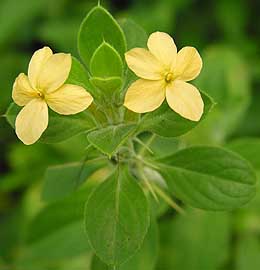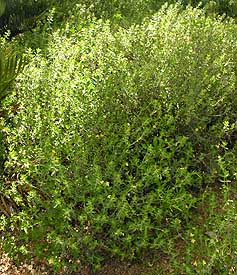Barleria holubii
Barleria holubii C.B. Clarke
Family: Acanthaceae
Common names: bushveld joy
Introduction
If you are an indigenous plant lover and you need an attractive, fast-growing, hardy plant for the rocky areas in your garden, Barleria holubii is the answer to your problem.

Description
Description
Barleria holubii is a dwarf, thorny shrub up to 800 mm high. The leaves are ovate to obovate (egg-shaped) and the leaf tips are armed with a sharp thorn. The stem is covered with thorns, especially at the leaf axils (the angle between the stem and leaf stalk). The small orange flowers have a long, narrow tube. It flowers almost the whole year except for June and July. The small seed capsule, present in most members of the Acanthaceae, bursts open when ripe to distribute the seeds. It is a fast-growing plant, reaching maturity in two years.

Conservation Status
Status
None.
Distribution and habitat
Distribution description
Barleria holubii grows in well-drained soil and in full sun in woodlands and hills in Mpumalanga, Limpopo Province and Zimbabwe. It is a water-wise plant but does well in wetter conditions. It can withstand mild frost quite well.
Derivation of name and historical aspects
History
The genus name Barleria is derived from the name of a Dominican monk and French botanist, Jacques Barrelier. The genus Barleria is found throughout Asia, Africa and America. It contains about 250 species with about 60 species in Africa. The genus includes species such as the white-flowered B. albostellata, mauve, blue or pink-flowered B. obtusa, and the rose-pink B. repens. Barleria holubii was named after Emil Holub, a 19th century European naturalist and explorer in Africa.
Ecology
Ecology
Barleria holubii is pollinated by insects and attracts various species of butterflies. The fruit capsule explodes to distribute the ripe seeds.
Uses
Use
Barleria species are ideally suitable to stabilize soil erosion, because of their fast growth rate and seed distribution methods.

Growing Barleria holubii
Grow
Propagation of Barleria holubii takes place either by seed or cuttings.
Collect the seeds as the capsules begin to turn brown. The seeds should be planted in a mixture of two parts good soil and one part clean river sand. Place the seed tray in a shady spot in the garden and water once a week. Germination of the seeds take place after a week. Transplanting the seedlings into bags should be done when the seedlings are more or less 100 mm high.
Take cuttings of 120 mm in summer and make use of plant material of the previous year's growth. Treat with a hormone powder and plant in a mixture of even parts good soil and river sand. Put the cuttings in a shady place and water twice a week. Transplant the rooted cuttings after about three months into a good soil mixture.
References
- Little, J.R. & Jones, C.E. 1980. A dictionary of botany. Van Nostrand Reinhold, New York, Cincinnatti, Toronto & Melbourne.
- Retief, E. & Herman, P.P.J. 1997. Plants of the northern provinces of South Africa: keys and diagnostic characters. Strelitzia 6. National Botanical Institute, Pretoria.
- website: http://backyardgardener.com/gardendictionary/holubi.html.
Credits
Willem Froneman
Lowveld National Botanical Garden
February 2009
Plant Attributes:
Plant Type: Perennial
SA Distribution: Limpopo, Mpumalanga
Soil type: Sandy, Loam
Flowering season: Late Summer, Autumn
PH: Neutral
Flower colour: Orange
Aspect: Full Sun
Gardening skill: Easy
Special Features:
Horticultural zones








Rate this article
Article well written and informative
Rate this plant
Is this an interesting plant?
Login to add your Comment
Back to topNot registered yet? Click here to register.